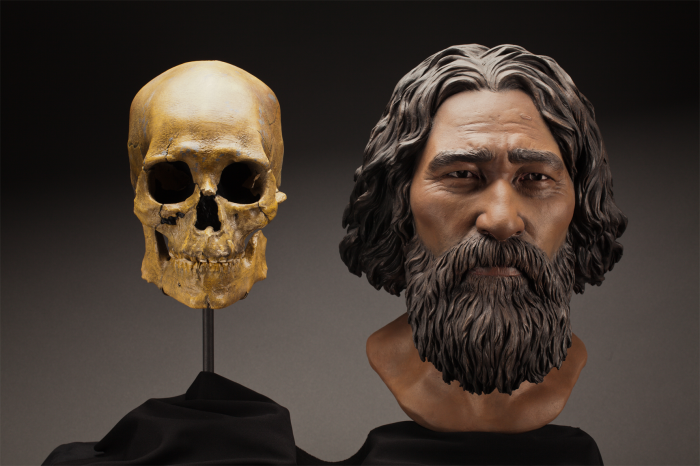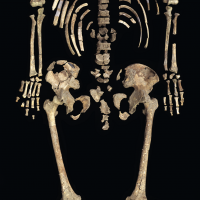Bringing “The Ancient One” to life

This clay facial reconstruction of Kennewick Man was carefully sculpted around the morphological features of his skull, and lends a deeper understanding of what he may have looked like nearly 9,000 years ago. In September 2014, Smithsonian forensic anthropologist Douglas Owsley will publish a new book entitled “Kennewick Man: The Scientific Investigation of an Ancient American Skeleton,” providing the most thorough analysis of any Paleoamerican skeleton to date. (Sculpted bust of Kennewick Man by StudioEIS based on forensic facial reconstruction by sculptor Amanda Danning. Photo by Brittney Tatchell)
Nearly 20 years after the prehistoric bones of Kennewick Man were serendipitously discovered along the banks of the Columbia River in Washington State, the scientific saga of his life and legacy is being told. A new book, Kennewick Man: The Scientific Investigation of an Ancient American Skeleton, will be published in September by Texas A&M University Press. Co-edited by forensic anthropologists Douglas Owsley at the Smithsonian and Richard Jantz at the University of Tennessee, the book provides the most thorough analysis of any Paleoamerican skeleton to date.
The findings reveal key details about Kennewick Man’s identity, including where he lived nearly 9,000 years ago, his lifestyle and his approximate age at death. The relationship of Kennewick Man to ancient and modern human populations stretch beyond the life of just one individual, providing scientists with a new window into the ancient migration of people to the New World and the experiences of early Americans.
Kennewick Man was about 40 years old at the time of his death, the cause of which remains a mystery. Other humans buried him at the gravesite where his body was found. Kennewick Man’s skull morphology does not easily fit into any major populations today, but most closely resembles Pacific Rim populations such as the Ainu of Japan and Polynesians, reflecting deep roots in coastal Asian groups. A facial reconstruction of Kennewick Man housed at the National Museum of Natural History suggests what he may have looked like.
“The human skeleton teaches us a wealth of information about human population dynamics across time,” said Owsley, division head of physical anthropology at the National Museum of Natural History. “Kennewick Man has become a teacher for all ages, acting as an informative ambassador to the ancient past in North America.”
Owsley and his colleagues conducted an extensive, interdisciplinary analysis of Kennewick Man’s remains with the support of about 50 physical and forensic anthropologists, archaeologists, geologists, geochemists and others, who studied the nearly 300 bones and fragments that were discovered in July 1996. The resulting studies concluded that Kennewick Man was tall for his time at 5 feet, 7 inches and well-muscled. His 163-pound, wide-bodied frame helped him navigate the steppe-like habitat of along the northwest coast of North America where he hunted and fished. Kennewick Man, called the “Ancient One” by American Indians, lived among big-game animals such as deer, pronghorn antelope and bighorn sheep, but primarily consumed fish and marine mammals. This diet, along with Kennewick Man’s reliance on glacial meltwater in rivers, is consistent with the lifestyle of a traveler from the northern part of the continent who made his way down the Pacific coast to Washington state. His hand, arm and shoulder bones suggest that he was right handed and was adept at flint knapping and throwing spears with an atlatl. Kennewick Man survived two major injuries during his life, including six broken ribs from blunt-force trauma to the chest and an adversarial encounter with a spear. The resulting impact left him with a stone projectile point permanently lodged in his pelvis for many years years during his lifetime.
In addition to discussing the life of Kennewick Man, the book sheds light on other ancient burial sites. There is a chapter about On Your Knees Cave in southeast Alaska where the bear-scavenged remains of a 10,200-year-old young adult male were found, and another featuring Horn Shelter #2 in central Texas, which contained skeletons of a young child and man buried with distinctive cultural items that identify the man as a shaman. The analyses of these sites provide a broader context for understanding Kennewick Man’s place in the Paleoamerican world, a time period that has produced few well-preserved, nearly complete skeletons.
Owsley and his colleagues plan to continue their study of Kennewick Man in the future to answer remaining questions about his identity. Research on Kennewick Man took place over the course of two visits and 16 days in 2005 and 2006 following a court ruling permitting the study of the remains, which are currently housed at the Burke Museum of Natural History and Culture at the University of Washington in Seattle.
Read more about Kennewick Man at Smithsonian.com.
- National Museum of Natural History forensic anthropologists Douglas Owsley and Kari Bruwelheide examine the ancient skeletal remains of Kennewick Man during 16 days of study in 2005 and 2006. (Photo by Chip Clark)
- Forensic anthropologist Kari Bruwelheide arranges Kennewick Man’s remains, which revealed that he was tall for his time and used his wide-bodied frame to navigate the Pacific northwest coast as a traveler and hunter of marine mammals. (Photo by Chip Clark)
- The morphology of the skull and long bones led National Museum of Natural History researcher Douglas Owsley and his colleagues to conclude that Kennewick Man likely shared ancestors with Asian coastal groups, including deep connections with the predecessors of contemporary Polynesians. (Photo by Chip Clark)
- A stone projectile point embedded in Kennewick Man’s right hip gave researchers the first clue that he belonged to an ancient human population; the spear point likely became lodged following an adversarial encounter.(Photo by Chip Clark)
- The exceptionally well-preserved skeleton of Kennewick Man is represented by nearly 300 bones and bone fragments. (Photo by Chip Clark)
Posted: 25 August 2014








